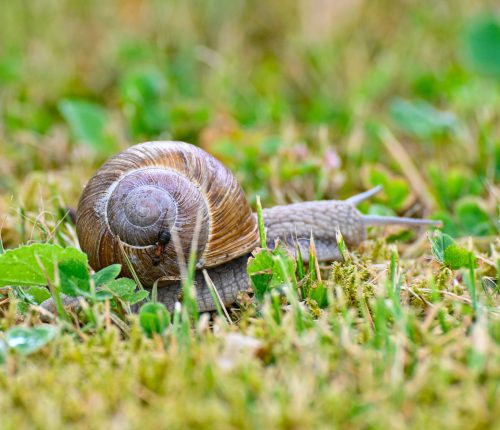- Turf
- Artificial
- Soil
- Timber
- Composite Decking
- Paving & Stone
Get In Touch With Our Experts Today!
Give us a Call! - Seed & Fertiliser
- Dressing
- Bark

June 18, 2024
Whether you can see them or not, snails and slugs are never far from your garden! To many of us, they look like slow, simple, slimy animals that surely couldn’t cause too much damage to your flowers, hedges or lawn. The truth is yes, they can! Especially if they’re left to their own devices and allowed to multiply.
For this article, we’re getting into the slippery world of slugs and snails: why they love your garden, the damage they cause, and how to get rid of them!
As harmless as they may appear, slugs and snails have a dark side when it comes to your garden lawns and outdoor spaces. They have a ravenous appetite and will munch on anything they can get a hold of, including grass blades, leaves and stems. If not dealt with early on, they can cause serious damage to the health of your plants and turf.
These slippery folks feast on a mix of living and dead organic matter – content that is rife in your back garden. Growing seedlings and fresh grass shoots are particularly tasty for slugs and snails, but you’ll also find them in compost, mulch or where weeds, leaves and thatch are left to pile up.
You’ll notice slugs and snails in wetter, cooler months and shaded garden areas. These are their favourite conditions where they’ll be undisturbed because we’re not outside gardening as much. Similarly, a wet spring, which is quite common in the UK, will speed up these slow-moving creatures.
Although snails and snugs are destroying our lovely lawns and beautiful blooms, we don’t want to cause them any harm. There are several humane ways to rid your garden of snails and slugs, allowing it to flourish to its full potential.
We strongly recommend wearing gloves, especially if you’re a little squeamish. Gently pick each creature up from your lawn or plants and remove it to a different location. To avoid them making their way back, you can place them in your local wooded area.
While maintaining your lawn’s condition, there’s also a lot you can do to make it an unappealing snack to snails and slugs.
1. Keep your lawn clear
By regularly raking your lawn, you remove any debris or organic matter. Not only does this clear your lawn’s surface, allowing more sunlight to reach your grass roots, but it also removes any delicious treats that attract slugs and snails.
2. Encourage birds in
Birds are natural predators of slugs and snails and can do a lot of the hard work for you! By including bird baths, bird feeders and bird boxes in your garden, you invite birds to visit regularly and help keep your lawn and flowerbeds free from pesky pests.
3. The melon method
It might sound a little weird, but it works, so bear with us! Place a slice of melon (with the rind) on your lawn. The melon’s sweet scent attracts the slugs and distracts them from harming your healthy turf. Once you spot a few slugs and snails on the melon, you can easily move them all at once.
4. Scatter coffee beans
This is a great way to recycle your coffee! By spreading coffee granules around the base of your plants and hedges, flowerbeds and lawn edges, you naturally deter slugs and snails from munching on your foliage. They also offer a delightful coffee scent, but be mindful if you have any pets.
5. Create bug hotels
By dedicating a specific spot for slugs and snails to thrive on, you distract them from the flowers and lawn you’ve worked so hard to nourish. Use bricks, stones and bits of wood to create a structure. Then add debris like moss, twigs and leaves to attract unwanted critters away from your garden.
6. Deadheading and trimming back
Snails and slugs rely on their body’s water content to survive, so they thrive in damp areas. By deadheading plants, removing weeds and cutting back overgrown branches and hedges you remove their dream destinations. Instead, you allow more light to come through and keep those areas warm and dry – everything they hate!
As successful as the above strategies are, there’s always the exception where they might not fully work. In those instances, you do have two more options:
1. Use slug repellents
Not everyone likes to use slug repellents, especially if you own pets such as cats and dogs who could accidentally eat them. However, if you choose to use them, you simply require a ring of pellets around the base of your plant to stop slugs from reaching, climbing, and munching on them. You can also pick up nature-friendly slug pellets.
2. Call pest exerts
If you notice a particularly bad or intense infestation of snails and slugs and you’re unsure how to deal with them, we recommend speaking to a pest expert who will provide professional advice on how to deal with the situation effectively and safely.
Snails and slugs are natural inhabitants of your garden; you can’t altogether avoid them! However, there are ways to spot them and easily get rid of them.
For more hints and tips on how to look after and nurture your lawn, view our helpful blogs or contact the George Davies team.